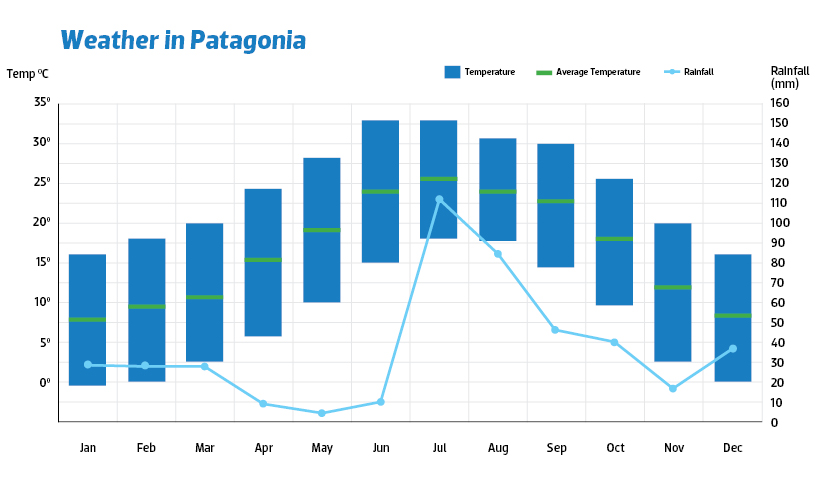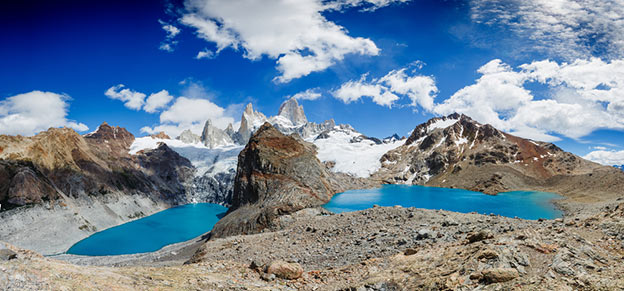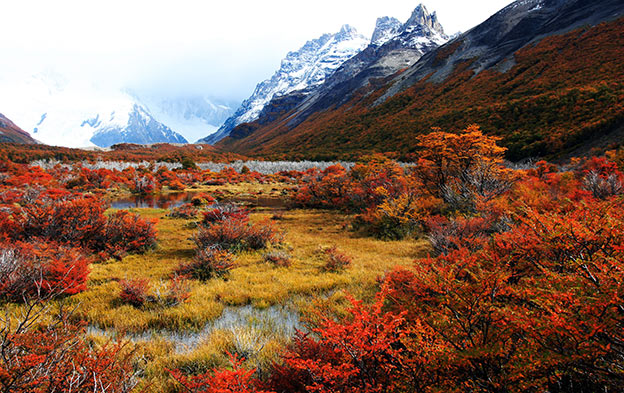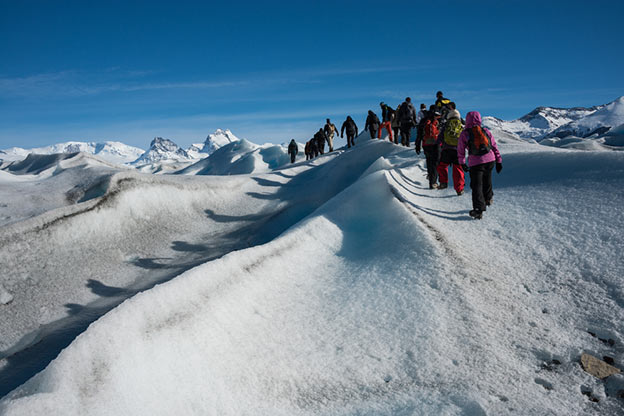When is the Best Time to Visit Patagonia
Updated June 2019
Stretching for a mind-boggling one million square kilometres over two countries (Argentina and Chile), Patagonia is an exceptional wilderness paradise and the eclectic array of highlights means the best time to visit solely depends on what it is you want to do, once there. Are you keen to hike in the best national parks in all of South America? Do you want to get up close and personal with Patagonian wildlife? Visit astonishing fjords and glaciers by boat? Or do you want to enjoy a stint of skiing down some of South America’s most coveted slopes? Your ‘must-see and do’ list is the main thing that will determine when the best time to visit Patagonia is, for you.
On this guide, we outline the dramatic seasonal differences in Patagonia and highlight the main attractions, per season. Whether it’s catching glimpses of migrating whales in the Valdes Peninsula, hiking the formidable Torres peaks, waddling with penguins, visiting the magnificent Perito Moreno glacier, sailing along the Chilean fjords or exploring Tierra del Fuego whilst awaiting your Antarctica cruise, we’ll help you hone in on the right month you should be planning your trip.

Summer – Dec/Jan/Feb
The height of the tourist season in Patagonia, the southern summer offers the best of Patagonia if you wish to spend most of your time soaking up the amazing wilderness. Between mid-December and mid-February, you’ll encounter ideal conditions for extensive trekking, with average daytime highs around 20 °C and lows of 10°C at night. Do note that the wind-chill factor in Patagonia can be strong and can drastically reduce the temps, even at the absolute height of summer.
Here are the benefits of visiting Patagonia’s in Summer:
- Up to 18 hours of daylight, ideal for long day-hikes
- All refugios (hiking huts) and hotels are open, every activity is on offer and all trails are accessible during these months
- There’s an amazing amount of wildlife to be seen in Summer. Having said that, peak crowd numbers can scare herds well away from the most popular and visited trails
The best highlights of Patagonia in Summer:
Torres del Paine National Park – Patagonia’s foremost attraction is a wildlife mecca, and is also considered the continent’s best trekking destination. It’s this double whammy that makes Torres so enticing. For arduous hiking around the cerros, or any other day trip in fact, you’ll definitely want long days and the best chance of warmer temps, so head here in summer and you’ll experience this treasure-trove of Mother Nature at her very best.
Insider tip: Read a few guide-books about Torres del Paine and they’ll all invariably name the same top 5 most popular hiking trails of all. Want to see more wildlife in summer? Skip ANY that are mentioned in all the top guides and pick an unknown trail you happen to discover when you get there. Trust that the views and scenery will be jaw-dropping no matter which trail you take, but if you share a trail with fewer trekkers, your wildlife-spotting chances will increase exponentially
Los Glaciares National Park – A glistening icy wonderland home to 47 major glaciers (including uber-famous Perito Moreno), Los Glaciares is one of South America’s most precious UNESCO-listed parks. It covers an area of over half a million hectares, boasts glacial lakes, spectacular snowy peaks and a vast maze of hiking trails. Although the park is open all year long, allowing for visits to Perito Moreno’s constantly calving façade, Summer is ideal to explore the park at length, over several days. In Summer, you can take boat trips and reach its remotest corners, head off on day hikes and even multi-day treks. Although crowds will be substantial, the park (as is the case with all of Patagonia) is extensive enough that it never feels overcrowded, especially outside the most famous viewing spots and trails.

Cruise the Chilean fjords – One of Patagonia’s hidden secrets, the fjords of southern Chile are off the well-trodden trail and, given their remote location, best discovered by small ship cruise. On a 5-day expedition, you can cruise alongside imposing glaciers, volcanoes and waterfalls and have options for kayaking and hiking as well. Summer is the ideal season for these kinds of exploratory trips in Patagonia and considering the most popular cast-off points are Punta Arenas and Ushuaia, many cruising aficionados will add this to their Antarctica cruise itinerary.
Insider tip: Just because you visit Patagonia in ‘summer’, it doesn’t mean you should be blasé about the weather. The climate is infamously unpredictable down here so you should always come prepared for freezing cold temps, especially if hiking is on your agenda. Read our Patagonia packing guide before you go.
Explore Bariloche – The lake area around Bariloche is an active traveller’s playground in Summer, with sensational horseback riding, mountain biking, kayaking and hiking excursions offering you the chance for much greater explorations when compared with the Winter months. The town (and region’s) gastronomic delights, including THE best chocolate in all of South America as well as some of its most prized wines, will be all there for the taking during the warmer months.
Cruise to Antarctica – Antarctica cruising season runs from about mid-October to March and most guests who choose cruises departing Ushuaia will undoubtedly want to take advantage of the fact that they’ll be flying into Patagonia to board their ship. Given that, in this case, Antarctica dates will be the main priority, it reasons that you should have your cruise plans finalised before planning a tour of Patagonia, either before or after your Antarctic expeditions. Ushuaia is the heart of Tierra del Fuego and is a phenomenal base for exploring the southern end of Patagonia. On your way to/from Ushuaia, for example, you can stop by El Calafate, the base point for visiting Los Glaciares NP and Perito Moreno. If you have even just an extra travel week up your sleeve, you can make amazing use of it in Patagonia.
Insider tip: Do note that Patagonia really is a very vast region and outside of a few ‘tourist hot-spots’, you’ll find this incredible region blissfully uncrowded, even at the height of Summer. ‘Tourist peak’ is a very relative concept. The only thing to keep in mind, however, is that Patagonia is not awash with hotels, lodges and estancias, in some parts, choices are quite limited so the only thing to keep in mind – in regards to Summer travel – is that you ought to book well in advance.

Shoulder Seasons
If you want to skip the busiest period of the year (from mid-December to mid-January) then consider travelling to Patagonia during the shoulder the Spring and Autumn. Both these seasons offer phenomenal benefits to those willing to forego extensive hiking, in order to gain in other facets of the experience.
Here are the fantastic benefits of visiting Patagonia in the Shoulder Seasons:
- Visit in Spring and you’ll see wildflowers in full bloom
- Visit after Summer for jaw-dropping Autumn foliage
- Temperatures in the shoulder seasons will still be manageable for spending time outdoors, you’ll just need to pack an extra layer
- You’ll find cheaper prices across the board for flights, accommodation and activities
- Greater availability on accommodation & small ship cruising means you can book closer to your travel dates.
The best highlights of Patagonia in the Shoulder Seasons:
Patagonia Wildlife Watching: Higher chances of seeing large herds of guanacos and other wildlife in Torres, given the lower visitor numbers. In this case, visiting at the beginning of November is absolutely ideal. As it happens, wildlife prefers a quieter ambience which means the fewer people around you, the more likely they are not to scoot away.
Peninsula Valdes: It’s hard to imagine that this desolate and seemingly inhospitable stretch of southern Argentinian coast could be a hub for so many species of marine mammals. But there you are, in UNESCO-listed Peninsula Valdes, watching killer whales hunt their prey with meticulous precision. Valdes, one of the world’s foremost marine-life watching destinations, boasts no less than three tranquil gulfs, which attracts nesting and mating marine mammals all year long. Dolphins, fur and elephant seals and sea lions can be seen at any time of year but for that extra sparkle of whale-watching magic, head to Valdes in October, when magnificent Southern Right Whales gather in impressive numbers. At the other end of the shoulder season, in March, you’ll see the largest nesting colony of Magellanic penguins, the largest in the world, in fact. This is a Patagonia spectacle that’s not to be missed.

Winter – April to August
Many parts of Patagonia freeze over and are inaccessible between the months of May and August, making travel here during this time a harder logistical challenge. Given that most lodges and parks close for the Winter, you may imagine there isn’t much to do down this far south. But you’d be mistaken. Sure, you can’t venture far from the doorsteps of the few amazing lodges that stay open all year long but, in exchange for that slight inconvenience, you’ll soak up the sight of a landscape whose beauty seems intensified, tenfold.
Options may be limited in Winter but, what is available, is absolutely breathtaking.
The benefits of visiting Patagonia in Winter:
- Arguably the cheapest prices of the year on all accommodation
- You’ll feel like you have all of Patagonia to yourself
- There’s still a LOT to do here, including hot spring soaking, wine tasting and snow-sports
- There are still some hiking options, ideal for hard-core experienced trekkers
- Peninsula Valdes will enjoy much warmer temps than any spot further south and there will be plenty of marine life to view
Here are some of the special highlights of Patagonia in Winter:
Hiking in Torres del Paine – Yes, your hiking options will be limited in Torres but they won’t be inexistent. Summer in Patagonia is plagued by strong winds yet Winters are miraculously calm so the climate can actually be more predictable (predictably cold, that is). Visit Torres in Winter and you’ll still be able to access some viewpoints and take a few of the shorter hiking trails.
Los Glaciares National Park: Snow-shoeing treks in Los Glaciares are all the rage so if snow is what you love most, you’ll be in absolute heaven here.
Luxury lodge stays: A few of Patagonia’s most luxurious lodges stay open in Winter and, given the discounted rates, can offer superb chances for super luxe experiences. You can be soaking in your own private jacuzzi, overlooking a blinding white horizon of jagged peaks. Absolutely magical!
Skiing and snowboarding: Head to Bariloche or anywhere around the Lakes Districts of both Chile and Argentina, and you’ll have the continent’s best ski lodges and runs at your fingertips. Patagonia is a winter lover’s playground.

Summertime, wintertime or any time of year is the very BEST time to visit Patagonia. Need help in planning your once-in-a-lifetime jaunt through this incredible part of the world? We offer a collection of Patagonia experiences that’s almost as exhaustive as the list of its highlights, including luxury trips, active adventures and tailor-made journeys.
Contact us for more info.
